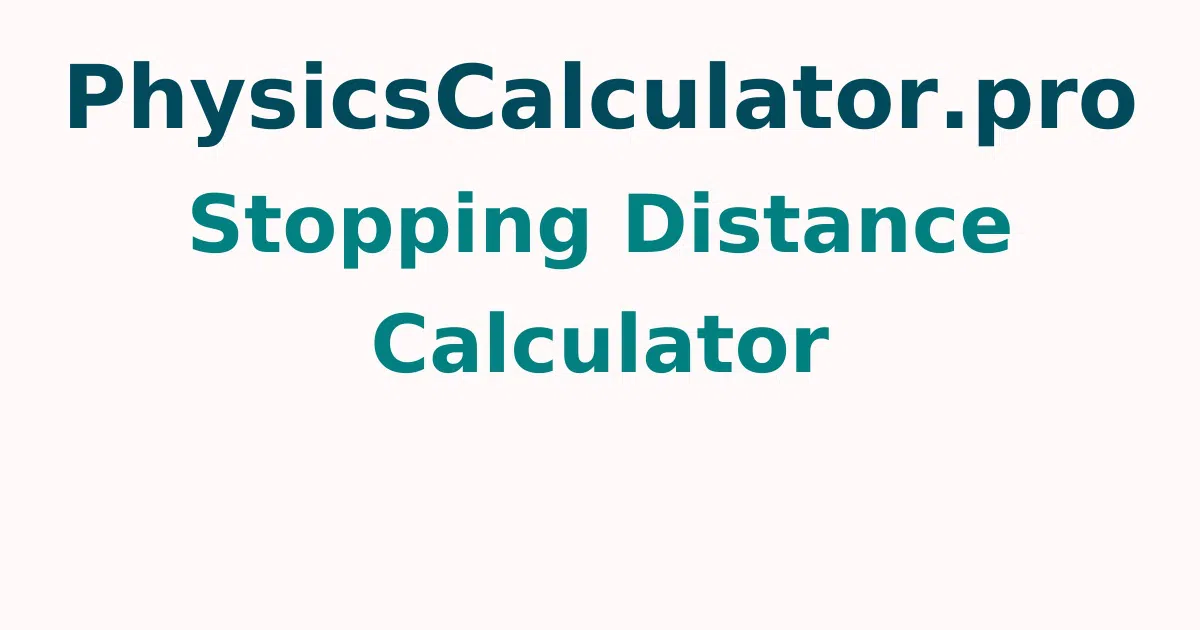Stopping Distance Calculator
The Stopping Distance Calculator is a free tool that calculates a vehicle's stopping distance. By entering the car speed, perception-reaction time, grade, and road conditions, then press the calculate button, you can quickly compute the stopping distance.
Perception-Reaction Time | Stopping and Braking Distance
If you're driving a car on a city street. You suddenly spot an elderly person crossing the road in front of you. The perception time is the period between seeing an event and reacting to it. You may believe you apply the brakes right away when you realise the hazard, but there is a little delay between when you notice the risk and when you begin to slow down. The reaction time is another name for this delay.
AASHTO Formula
Using the AASHTO formula, calculate an automobile's stopping distance (the American Association of State Highway and Transportation Officials). This AASHTO formula is used in road design to establish the minimum stopping sight distance. Factors such as road conditions (dry or wet), vehicle speed, perception-reaction time, and others influence the stopping distance. The following is the AASHTO Formula s = (0.278 x t x v) + v²/(254 x (f + G))
- Where, f = The coefficient of friction between the tyres. On a dry road, it equals 0.7, whereas, on a wet road, it goes from 0.3 to 0.4.
- s = stopping distance
- t = perception-reaction time
- v = speed of the car
- G = grade (slope) of the road. It is positive when the road is heading uphill and negative when the road is going downhill.
For more concepts check out physicscalculatorpro.com to get quick answers by using this free tool.
How to Calculate the Stopping Distance?
The steps to calculating a vehicle's stopping distance are as follows. Follow the steps given and you'll get the result in the blink of an eye.
- Step 1: Make a note of the friction coefficient, vehicle speed, and perception-reaction time.
- Step 2: Multiply the car's speed by 0.278 and the perception-reaction time.
- Step 3: Add the coefficient of friction with the road grade, then multiply by 254.
- Step 4: Divide the product from the square of the car's speed.
- Step 5: To calculate the stopping distance, add the results from steps 2 and 4.
Stopping and Braking Distance Examples
Question 1: A car is travelling at 70 m/s on a dry road when it abruptly applies the brakes. Find the stopping distance if the perception-reaction time is 20 seconds and the grade is 0.2 %?
Solution:
Given:
velocity of car v = 70 m/s
perception-reaction time t = 20 seconds
Grade G = 0.2%
coefficient of friction f = 0.7
Stopping distance s = (0.278 x t x v) + v²/(254 x (f + G))
s = (0.278 x 20 x 70) + 70²/(254 x (0.7 + 0.2))
s = 389.2 + 21.43
= 410.63
Hence, the car stopping distance is 410.63 m.
FAQs on Stopping and Braking Distance
1. Is a change in velocity considered deceleration?
Deceleration causes a decrease in speed or velocity magnitude. The acceleration that is opposed to the velocity is characterised as "deceleration" in one-dimensional motion.
2. How to calculate the stopping distance?
The AASHTO formula can be used to calculate a car's stopping distance. Get information about the perception-reaction time, grade, and speed. To calculate the car stopping distance, substitute the values in the formula and solve.
3. What is the definition of braking distance?
The distance a vehicle travels from when its brakes are fully engaged to when it comes to a complete stop is known as braking distance. It has an impact on the vehicle's real speed and the coefficient of friction between the tyres and the road surface.
4. Calculate stopping distance at 45 mph?
Speed = 45 miles per hour = 20.11 meters per second
Stopping distance s = (0.278 x t x v) + v²/(254 * (f + G))
s = (0.278 x 0 x 20.11) + 20.11²/(254 * (0.3 + 0))
= 404.41/76.2 = 5.30
The stopping distance at 45 miles per hour is 53 meters.
